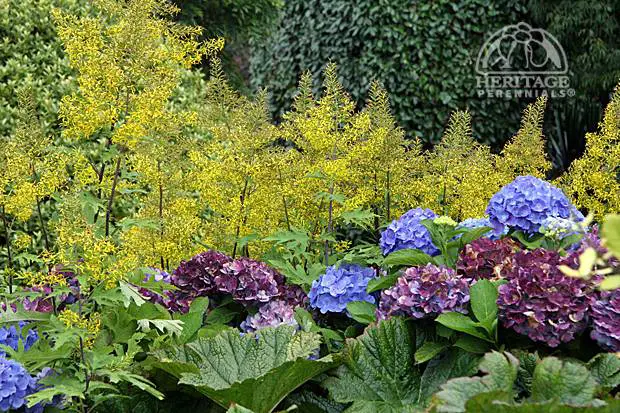Design & Layout
Design and Layout, Design Tips

1. An overwhelming choice
Modern gardeners are very fortunate to live in a time when the passion for perennial plants has reached a frenzy like never before. The selection is now overwhelming, to say the least. This is good in one sense, bringing diversity and greater possibilities into our lives, but it also makes the job of selecting the right plant ever more difficult. For myself, it is a nearly constant exercise to keep up on the newest and latest introductions.
2. Gardens start with a plan
Look at the basic landscape that you already have, and try to determine what the good and bad elements are. Removing any diseased trees or shrubs might be a good place to start. Changing the line of a sidewalk or the shape of a planting might be all that is required. A basic book on landscaping will come in very handy at this point (I highly recommend any of the books written by British garden designer John Brookes).
Rather than look at your entire yard, try to focus in on just a few spots that could use some improvement. If you re-work a few areas each year, it won’t take very long at all to see a remarkable difference in your whole garden.
3. Thinking ahead
The hardest part about designing with perennials is planning for colour over an extended season. Although certain varieties will bloom for many weeks on end, most perennials bloom for three to four weeks at the most. If all the varieties in your garden begin blooming in early June, there won’t likely be much colour left by September.
Check the blooming information under each plant listing, or check plant tags at your garden centre. This will help you to choose combinations that bloom at the same or different times, depending on the design you have in mind.
Ideally, a good selection of different perennials will give you colour somewhere in the garden from early April to late October. Learning which variety blooms at what time is part of the challenge of perennial gardening. One of the best ways to find out when plants are in bloom is to drop by your local garden centre throughout the year – they’re sure to have blooming perennials on display. You should also take a good look around your neighbourhood – try to take notes about when plants that appeal to you put on their best display. It is only one step further to begin combining different varieties together in clever ways that perhaps nobody ever thought of before!
4. Marjorie’s design trick
My friend Marjorie Mason Hogue told me of a clever way that she thought up to design for all-season interest without ever using graph paper or getting all complicated: simply stretch out your arms, and in an area of approximately that diameter, try to include a perennial that blooms in spring, one in summer and one in fall. For the finishing touch, include a fourth plant that primarily has good foliage interest. I think this is a simple and versatile way to include a variety of plants and achieve as close to year-round appeal as possible.
Let’s look at an example: in an area with morning sun perhaps you have a nice big clump of old-fashioned pink Bleedingheart (Dicentra spectabilis). This flowers beautifully in late spring, then during the heat of summer it usually collapses and looks shabby. We need a plant that will fill the gap later in the season. One that comes to mind is White Fleeceflower (Persicaria polymorpha), which gets to a height of 3-4 feet and flowers non-stop from July to September. Now… something for autumn colour could be one of the many Toad Lily selections (Tricyrtis). Then, let’s finish off the grouping with a clump or three of Barrenwort (Epimedium), which gives an airy but brief display of flowers in mid spring with handsome foliage that lasts all season long and most of the winter. We could go one step further and include a sprinkling of early spring flowering bulbs, such as Siberian Squills (Scilla), Snowdrops (Galanthus) and large purple Crocus. There you go – all-season colour in an instant, yet a variety of different plants that change over the course of seasons.
Planting a combination of four plants together can easily lend itself to all sorts of interesting designs. Try to imagine combinations of herbs, perennials and annuals, for example; no need to just stick to perennials alone. This little trick can easily be adapted to container gardening as well.
5. It’s never finished!
Because there is such a vast array of perennials to choose from, it would be difficult for anyone to become bored of growing them. For the addicted perennial gardener the possibilities become endless. Planning, arranging, planting, taking notes, rearranging again and again, these are the joys and challenges of perennial gardening. Indeed, most perennial fanatics would agree that the garden is never truly finished; there are always new ideas waiting to be tried. Those of you just recently bitten by the perennial-gardening bug – stand your ground, and tell your significant other to quit asking if it’s done yet …
Beginning gardeners, please don’t be scared off! One of the best things about perennial gardening is that it can be tailored to suit your needs, experience, and budget – there’s no need to convert your entire lawn into an English-style border all at once. Start with your current landscape as a base, and try to figure out a way to integrate perennials into what is already there. After all, you can always dig up the lawn next year.
— John Valleau, Corporate Horticulturist (excerpt from Designing Your Garden, Heritage Perennials Perennial Gardening Guide)